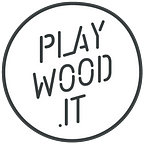We at PlayWood show what Open Design means at Fuorisalone 2017 in Milan
What is Open Design?
Open design is the development of physical products, machines and systems through the use of publicly shared design information.
This process has expanded hugely thanks to the internet and it is often used without any monetary compensation. The goals and philosophy are derived from the original concept of Open Source, a computer term for software whose authors (more precisely, rights holders) make the source code public, favoring free study and allowing independent programmers to make changes even if they are not working in the same place, thus allowing the remote collaborations.
So it has gone from sharing the source code of a software to the contents of a physical product design. Download our Open Design Manual.
The precursor of Open Design was the Italian Enzo Mari, publishing a book called “Autoprogettazione” containing plans and construction drawings, released with free and open license, a complete set of furniture designed to be easily manufactured and assembled by anyone. He decided to work on a design that transmits knowledge through self-manufacturing practice (DIY), a revolutionary approach at the time. Mari got much more than he intended, now his plans are adopted in production plants around the world as workshop objects and its dictates in design have spread virally among digital communities.
Today, to access these shared projects, of whatever nature, requires a number of licenses, called Creative Commons lincenses.
Creative Commons (CC) is a non-profit organization based in Mountain View dedicated to expanding the range of works available to the legal public sharing and use.
The organization has compiled different types of licenses that provide a simple, standardized way to communicate what rights the author reserves and other such waivers, for the benefit of users. This made way for the introduction of concept of “Some Rights Reserved” (some rights reserved) midway between the rigid copyright model “All rights reserved” (All rights reserved) and the too permissive model of public domain “no rights reserved” (No rights reserved).
The creator of a project that decides to lean on Creative Commons licenses must decide if he wants to allow commercial use and if the user can create derivative works from, in this case, asking anyone who uses the work to make it available and shared as the original plan. This operation is called “ShareAlike” and it is one of the mechanisms (if chosen) that helps the wealth of items available through digital commons grow over time.
From the very beginning we at PlayWood have been inspired by this philosophy and we are proud to make available to everyone, our open source design libraries to make furniture all over the world, using local materials thus reducing transportation costs.
Would you like to make your first open design furniture?
Download our free Open Design Manual. Make many projects all over the world.
